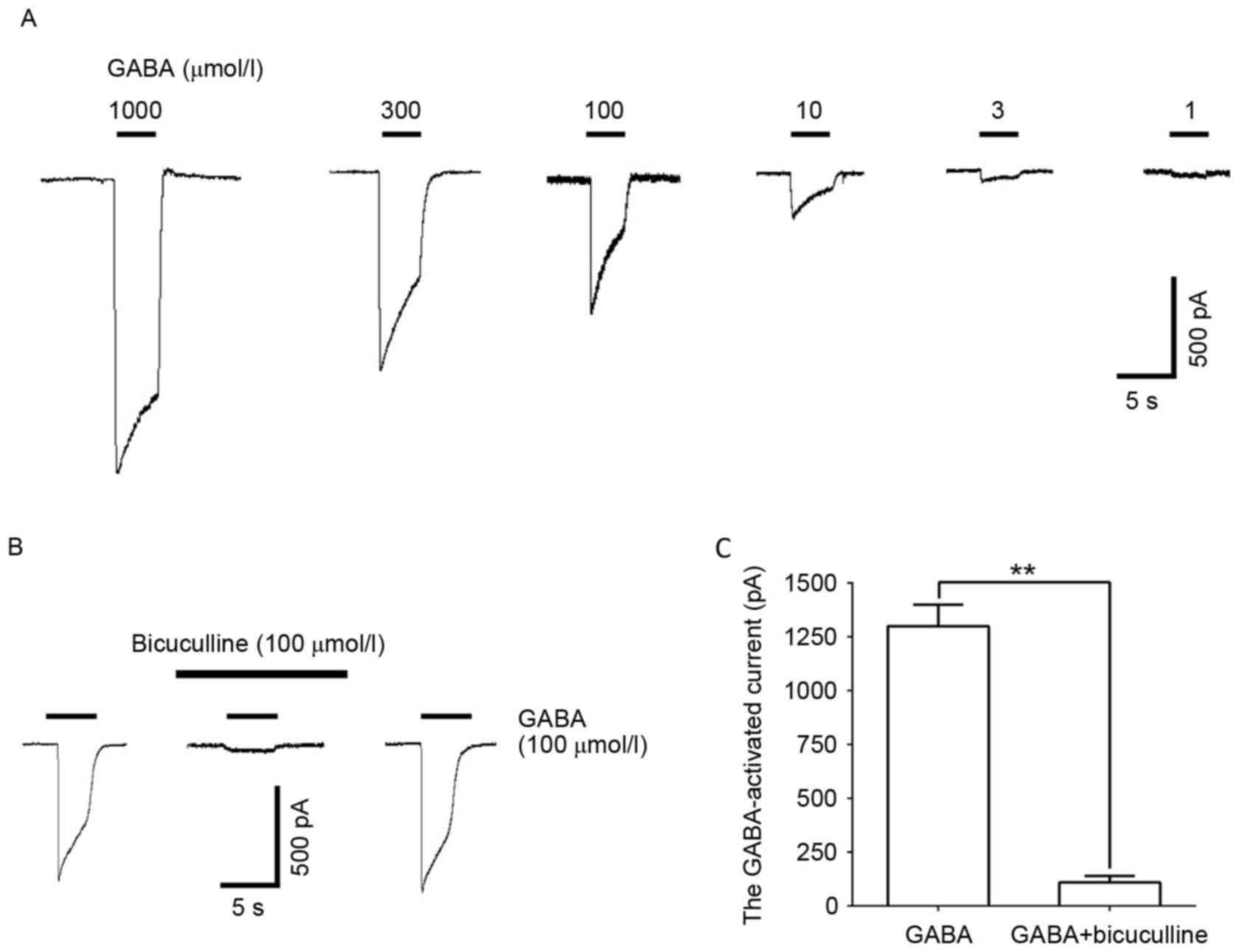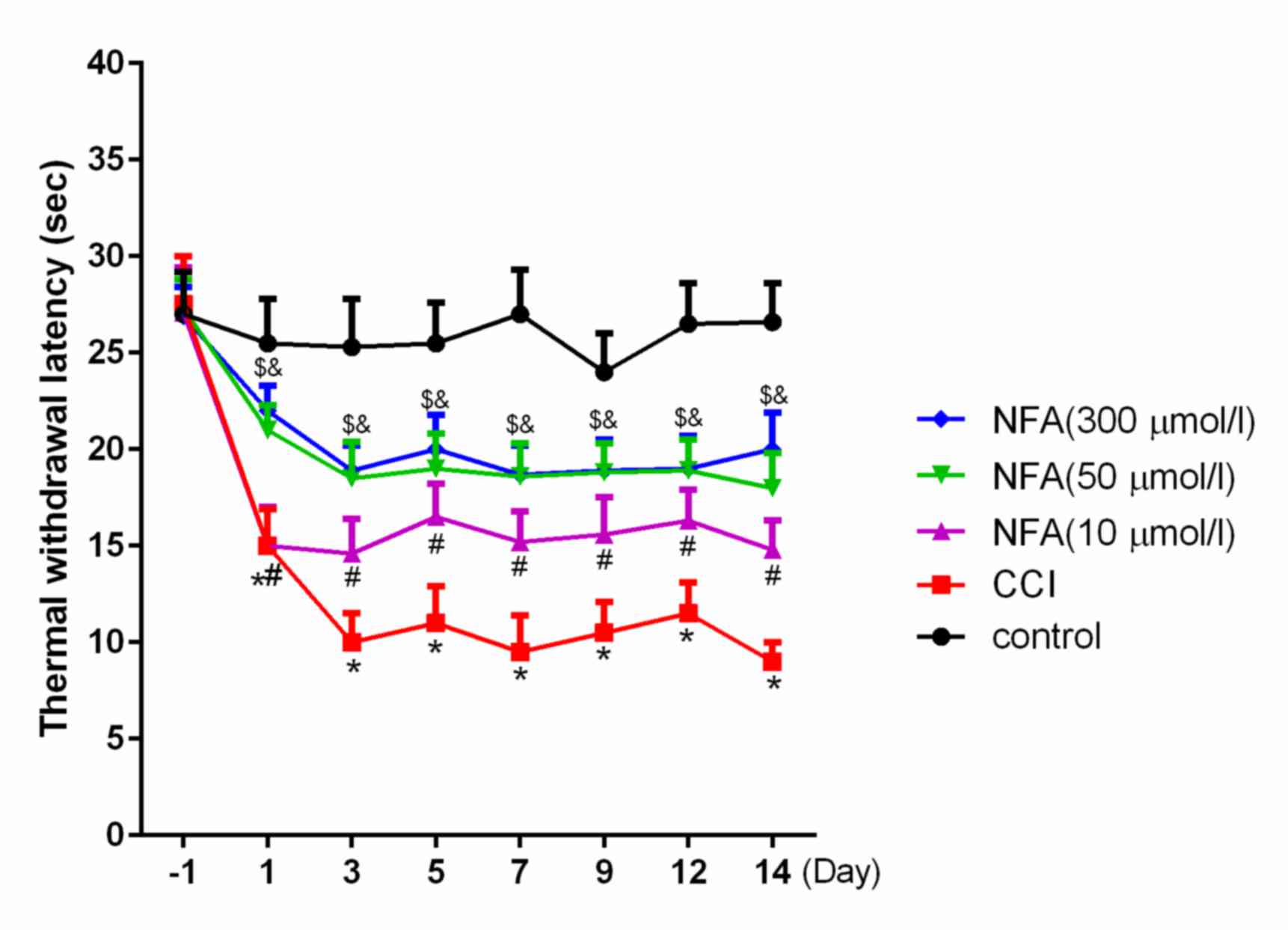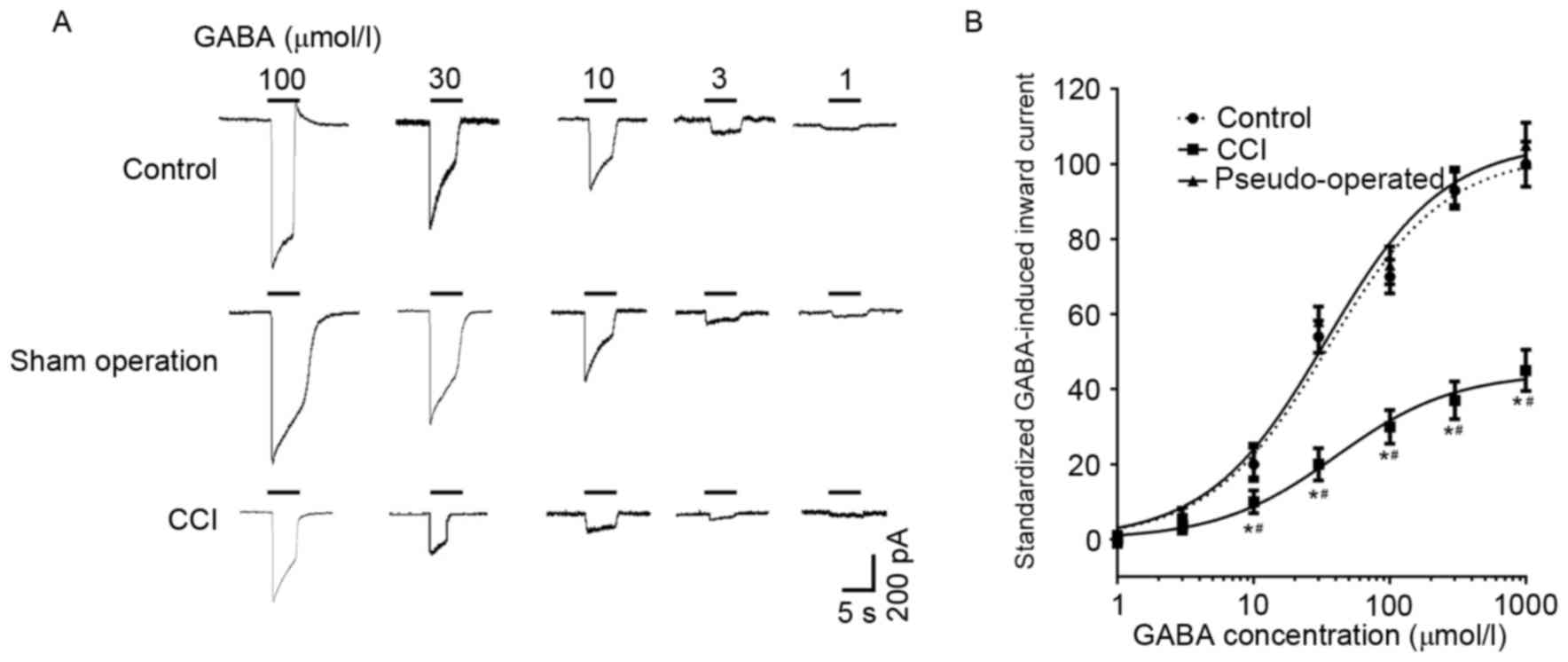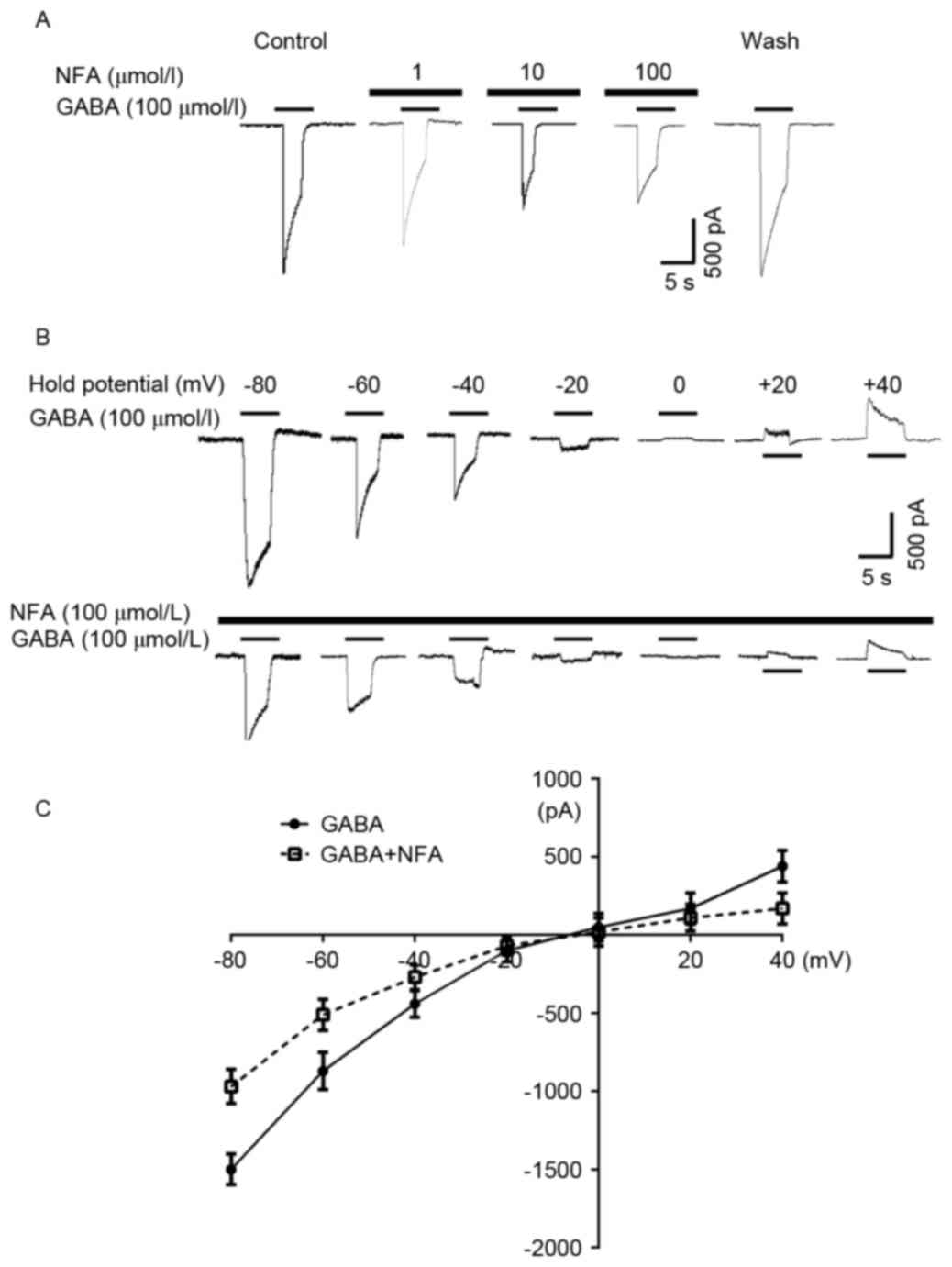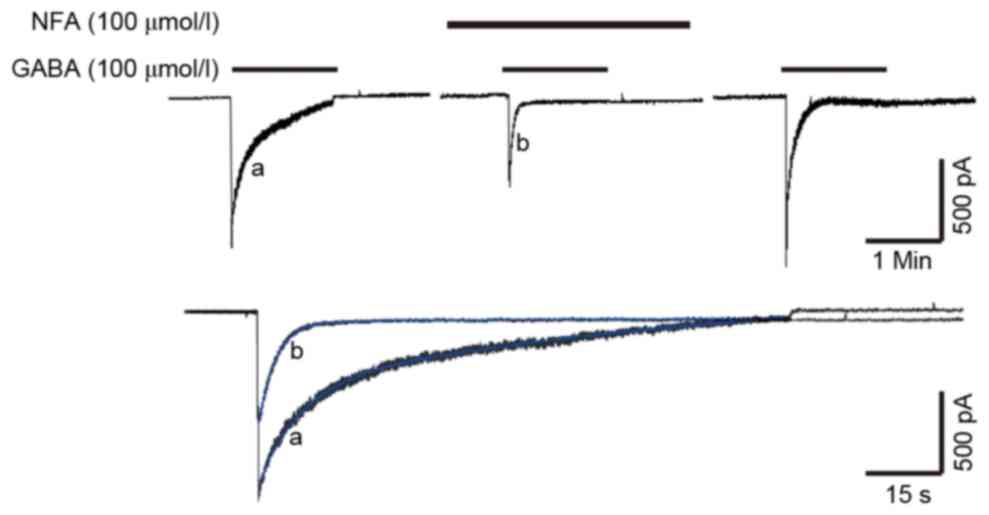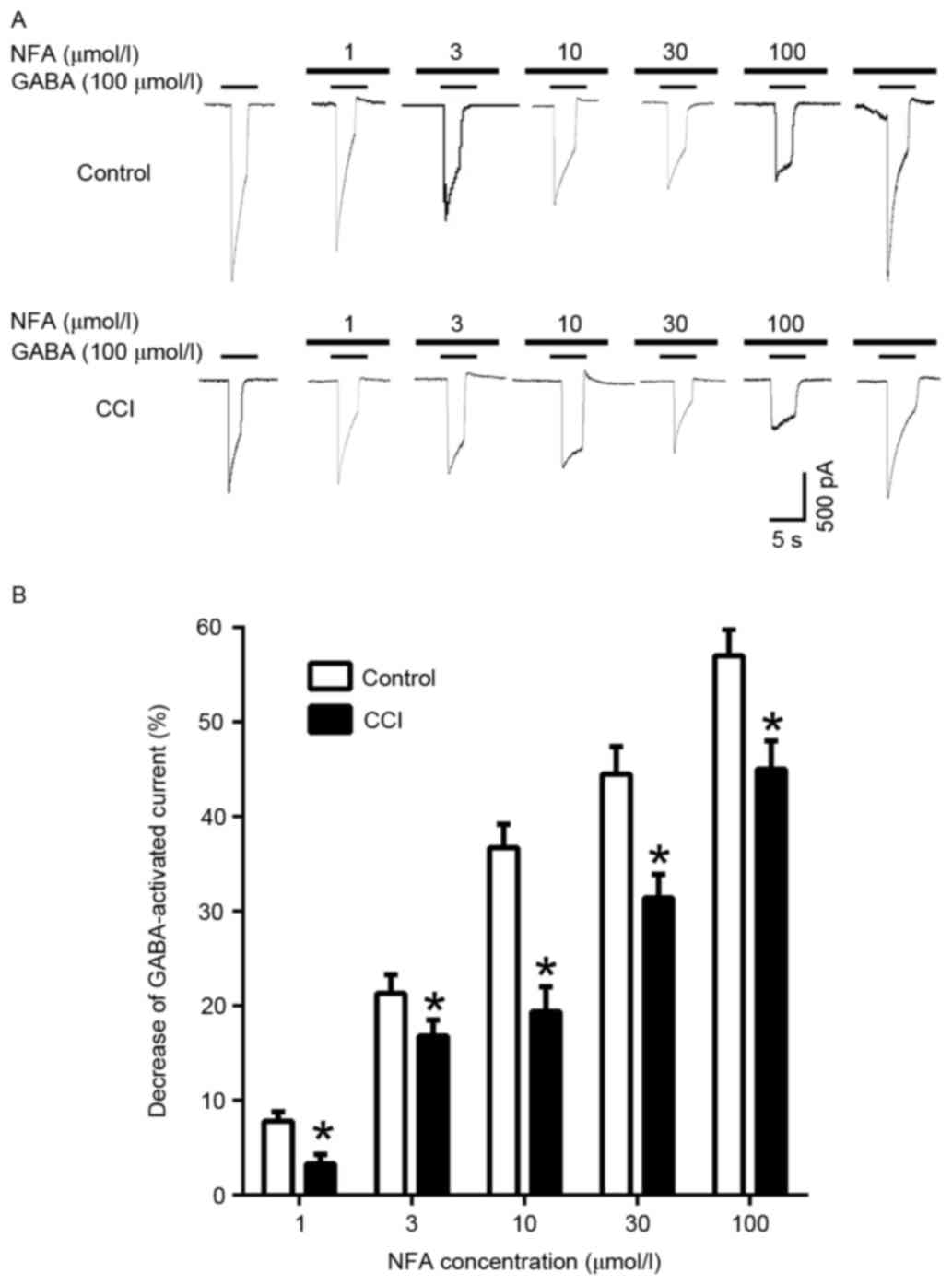Effects of niflumic acid on γ‑aminobutyric acid‑induced currents in isolated dorsal root ganglion neurons of neuropathic pain rats
- Authors:
- Published online on: June 26, 2017 https://doi.org/10.3892/etm.2017.4666
- Pages: 1373-1380
-
Copyright: © Wang et al. This is an open access article distributed under the terms of Creative Commons Attribution License.
Abstract
Introduction
Neuropathic pain is defined as pain initiated or caused by a primary lesion or dysfunction in the nervous system, which often presents as spontaneous pain and produces a sense of pain similar to that generated by noxious stimuli, including mechanical and thermal stresses (1). Neuropathic pain seriously impedes patient quality of life. The electrophysiological basis of neuropathic pain is related to an increase in the expression of Na+ and voltage-gated Ca2+ channels on the neuronal membrane of injured nerve sites, and the release of an excitatory neurotransmitter, which changes the normal physiological activity of neurons and aggravates neural responses to non-injurious and minor injurious peripheral stimulation (2,3). A large number of neurons spontaneously discharge and release ectopic impulses to the spinal neurons, which increases the sensitivity of spinal neurons and transmission between the synapses and neurotransmitters, thus increasing spinal excitability and causing abnormalities in sensory function (4).
γ-aminobutyric acid (GABA) in the central nervous system serves an important role in the processing of nociceptive information and the modulation of pain, and is the main inhibitory neurotransmitter (5). It has previously been demonstrated that GABA type A receptors (GABAARs) are involved in the transmission of pain (5,6). GABAARs are ligand-gated chloride ion channel receptors (5,6). A previous study by our group demonstrated that calcium-activated chloride channels (CaCCs) serve a critical role in the generation of GABA-induced inward currents in the dorsal root ganglions (DRGs) of rats (7). DRGs connect the peripheral and central nervous systems, and GABA and GABAAR are present in the DRG neurons of humans and animals (8). GABAA receptors in the DRG serve an important role in alleviating the symptoms of neuropathic pain (9,10).
Dorsal root reflexes were first systematically investigated in the 1930s (11,12), and were found to be triggered by primary afferent depolarization (PAD). The stimulation of primary afferent fibers produces PAD, which is blocked by GABAA antagonists such as picrotoxin and bicuculline, and also by antagonists of non-N-Methyl-D-aspartic acid (NMDA) glutamate receptors (13,14). The most likely explanation for this is that primary afferent fibers release excitatory amino acids, which then activate non-NMDA glutamate receptors on GABAergic interneurons, causing them to release GABA at axoaxonic or dendroaxonic synapses on primary afferent terminals (13). Possible reasons for an increase in dorsal root reflexes during inflammation include an upregulation of the GABA system in the dorsal horn via the action of signal transduction pathways (14). However, the superimposition of an excitatory mechanism (dorsal root reflexes) onto an inhibitory one (presynaptic inhibition due to PAD) may have negative effects (11). Instead of inhibition, hyperalgesia and allodynia may result from the central effects of dorsal root reflexes, and neurogenic inflammation may result from the peripheral effects (11).
Niflumic acid (NFA) is a type of non-steroidal anti-inflammatory drug (NSAID). NSAIDs are the most widely used pharmacological agents and exhibit a demulcent effect, principally by reducing the synthesis of prostaglandins via inhibition of cyclooxygenase at sites of pain and inflammation (15). NFA, a GABAAR antagonist, is the only chloride ion channel blocker able to protect cells from excitotoxicity (16). It has been suggested that NSAIDs modulate GABAAR function in heterologous expression systems (17). Chronic constriction injury (CCI) models were first used in 1988 and are now widely used in the study of neuropathic pain (18). The surgical techniques used to establish CCI models have many advantages, including a simple surgical procedure and small wound size, and the signs and symptoms of stable spontaneous pain, heat hyperalgesia and mechanical allodynia are similar to those observed clinically (18). In a previous study, the current authors demonstrated that NAF could inhibit GABA-induced current of dorsal root ganglion neurons in both control and CCI, but the mechanism was still unclear (19). The aim of the present study was to investigate the effects of NFA on GABA-induced currents in the dorsal root ganglion neurons of rats with neuropathic pain, and to evaluate the analgesic mechanism of NFA.
Materials and methods
Materials
A total of 40 healthy male Sprague-Dawley rats aged 8–10 weeks and weighing 250–280 g, were provided by the Experimental Animal Center of Xinjiang Medical University (Urumqi, China). Rats were housed in separate cages in a specific pathogen-free level barrier environment at 24±3°C, relative humidity of 40–70% and a 12-h light-dark cycle, and were provided with free access to food and water. The study was approved by the ethics committee of The First Affiliated Hospital of Shihezi University Medical College (Shihezi, China).
Establishment of the rat CCI models
A total of 40 rats were randomly divided into three groups: Control group (n=10), sham operation group (n=10) and CCI group (n=20). Rats were anesthetized with an intraperitoneal injection of 10% (w/v) sodium chloral hydrate [350 mg/kg body weight, Sangon Biotech (Shanghai) Co., Ltd., Shanghai, China], and the left sciatic nerve trunk was exposed under sterile conditions. The skin was longitudinally cut and muscle was dissociated by blunt dissection to fully expose the sciatic nerve, proximal to the sciatic trifurcation. Approximately 5 mm of nerve was freed, and 4 tight ligatures of chrome catgut were placed around the sciatic nerve with ~1 mm spacing. The tightness of ligatures was such that the blood supply to the epineurium was not affected. Rats in thee pseudo-operated groups underwent the same procedure but were not ligated. Rats were fed normally to recover post-surgery. To assess whether the model had been successfully established, paw withdrawal latency was assessed, as described previously (20), and in the model group values from the CCI ipsilateral side were significantly declined by ≥30% (P<0.05), which indicated modeling success. A total of 10 rats were randomly selected from each group.
Hot plate testing
To determine whether the CCI model had been successfully established, paw withdrawal latency was assessed (20). A Plantar Test (Hargreaves Apparatus; cat. no. 37370) was purchased from Ugo Basile S.R.L (Monvalle, Italy). The Plantar Test was used in accordance with the manufacturer's protocol. Thermal hyperalgesia was measured using an infrared intensity of 50, and expressed as paw withdrawal latency of the left hind paw. The mean of three measurements at 4-min intervals was regarded as the paw withdrawal latency. In order to prevent tissue damage, the maximum latency was defined as 30 sec, following which rats were removed from the plantar testing apparatus. Plantar testing was performed at the following time points: Pre-surgery and on days 1, 3, 5, 7, 10 and 14 post-surgery. Following plantar testing at each time point, rats were prepared for experimentation.
Electrophysiological recordings of dorsal root ganglion neurons
Rats were anesthetized with an intraperitoneal injection of 10% (w/v) sodium chloral hydrate (350 mg/kg body weight) and decapitated, and the cervical, thoracic and lumbar spine was immediately harvested. The spine was split longitudinally and placed in an extracellular fluid substitute, the composition of which was as follows: 150 mmol/l NaCl, 5 mmol/l KCl, 2.5 mmol/l CaCl2, 1 mmol/l MgCl2, 10 mmol/l HEPES (H3375; Sigma-Aldrich; Merck KGaA, Darmstadt Germany), 10 mmol/l D-glucose [A600219-0001; Sangon Biotech (Shanghai) Co., Ltd.], and NaOH to give a pH of 7.3–7.4 (osmotic pressure=330 mOsm). Ganglia and the associated nerve roots were individually removed under a stereomicroscope. The trimmed DRG was cut into pieces using eye scissors and transferred to an eppendorf (EP) tube that contained 0.25 mg/ml trypsinase (T1426; Sigma-Aldrich; Merck KGaA) and 0.5 mg/ml collagenase (C0130; Sigma-Aldrich; Merck KGaA). The EP tube was incubated at 37°C for 12 min, then mixed with 0.1 mg/ml trypsin inhibitor (T6522; Sigma-Aldrich; Merck KGaA) to cease digestion and centrifuged at 300 × g for 6 min. The supernatant was discarded and 2–3 ml extracellular fluid substitute was added for patch-clamp experiments and left to stand for at least 30 min at room temperature to allow cells to adhere. Whole-cell patch clamp recordings were performed at room temperature using a whole-cell patch clamp amplifier. Briefly, currents were recorded from single dorsal root ganglion neurons in vitro using an Axon 700B amplifier (Molecular Devices, LLC, Sunnyvale, CA, USA) and the pCLAMP 10.2 hardware and software (Molecular Devices, LLC). Microelectrodes (~1 µm diameter) were pulled using a P-97 puller (Sutter Instrument Co., Novato, CA, USA), and the impedance of each glass microelectrode was 3–5 MΩ. Microelectrodes were filled with internal solution containing 140 mmol/l KCl, 1 mmol/l CaCl2, 2 mmol/l MgCl2, 10 mmol/l HEPES and 11 mmol/l EGTA, and KOH (1 mol/l) to raise the pH to 7.3–7.4. Separated single cells that had adhered well and exhibited round or oval morphology, a clear shape and contour, membrane integrity, a uniform cytoplasm and a diameter of 15–45 µm were selected under an inverted microscope. The glass microelectrode was moved onto the cell surface using a micromanipulator (CV-7B; Molecular Devices, LLC, Sunnyvale, CA, USA). Vacuum suction was applied to form a high-resistance seal between the electrode and cell membrane, and the capacitance and series resistance were adjusted to maintain a voltage of −60 mV, as described previously (21,22).
Pharmacological agents were prepared with sugar-free extracellular fluid (as described above but without D-glucose). The drug delivery system comprised a micromanipulator which allowed rapid changing of drug delivery tubes. The diameter of every drug delivery tube was 0.5 mm and the distance between nozzle and cell was 100 µm. GABA (A5835; Sigma-Aldrich; Merck KGaA) (1–1,000 µmol/l) was administered from low to high concentration for 5–6 sec to establish a ‘front control’, with an intermission of 4 min during which cells were bathed in extracellular fluid. Bicuculline (285269; Sigma-Aldrich; Merck KGaA) was administered at 100 µmol/l. The same concentration of GABA was perfused as the front control. Prior to administering the mixture of NFA (1, 10 and 100 mmol/l; N0630-25 G; Sigma-Aldrich; Merck KGaA) and GABA (100 µmol/l), NFA (1, 10, 100 µmol/l) was pre-perfused for ~20 sec. After the GABA-activated current (IGABA) was steady and the cells had been bathed for 4 min, the mixture of GABA and NFA was perfused for 5 sec, when the IGABA recovered to the level of the front control, the other concentrations of NFA were perfused. The inhibitory effects of different concentrations of NFA on IGABA were recorded and the inhibitory rate of NFA on IGABA was calculated using the following formula: (IGABA-Imixture)/IGABAx100 (22,23).
DRG preparation and intracellular recording
A total of 20 male Wistar rats (age 2–3 weeks; weight, 200–250 g) were purchased from Xinjiang Medical University. Rats were housed in cages in a specific pathogen-free level barrier environment at 24±3°C, relative humidity of 40–70% and a 12-h light/dark cycle, with free access to food and water. Rats were anesthetized with an intraperitoneal injection of 10% (w/v) sodium chloral hydrate (350 mg/kg body weight) and decapitated, and the cervical, thoracic and lumbar spine was immediately harvested. The rats subsequently underwent a laminectomy at L4 or L5. DRGs with attached dorsal roots and spinal nerves were harvested and the fibrous sheath surrounding the DRG was removed under the stereoscope. The isolated preparation was transferred into a recording chamber (0.25 ml volume), and perfused with oxygenated balanced salt solution (BSS) at room temperature. The BSS contained 140 mmol/l NaCl, 5 mmol/l KCl, 1 mmol/l MgCl2, 5 mmol/l glucose and 5 mmol/l Tris-HCl (RES3098T-B701X; Sigma-Aldrich; Merck KGaA) (pH 7.4). The flow rate was 3–5 ml/min. The preparation was pinned with small steel pins (0.5 mm) onto a silicone gum block, which was placed in the chamber. The sciatic nerve was placed on a pair of platinum stimulating electrodes in the neighboring compartment, as described previously (9).
Intracellular recordings were obtained using a glass microelectrode (1 mm diameter) filled with 2 mol/l KCl and 1 mol/l potassium acetate, the impedance of each glass microelectrode was in the range of 25–60 MΩ. Membrane potentials were amplified with a microelectrode amplifier (MEZ-8301; Nihon Kohden, Tokyo, Japan) and membrane depolarization was filtered at 20 Hz (as previously described) (9). Data were recorded with a pen recorder (cat. no. XWTD-264; Shanghai Instrument Group Co., Ltd., Shanghai, China). The values acquired for resting membrane potentials used in the preparations were stable for 10–20 min.
Statistical analysis
Data were analyzed with SPSS 17.0 software (SPSS, Inc., Chicago, IL, USA) and presented as the mean ± standard error of the mean. A homogeneity test for variance was performed followed by one-way analysis of variance, and two-group comparisons were conducted using the least significant difference t-test. P<0.05 was considered to indicate a statistically significant difference for all experiments.
Results
Characteristics of GABA-induced currents in dorsal root ganglion neurons
GABA (1–1,000 µmol/l) administration induced a concentration-dependent inward current in DRG neurons (Fig. 1A). This reaction was significantly blocked by the GABAAR selective antagonist, bicuculline (100 µmol/l; P<0.01; Fig. 1B and C), illustrating the GABA-induced inward current induced by the GABAAR.
Effects of NFA on thermal hyperalgesia in CCI rats
The effects of CCI on behavioral displays of hyperalgesia were investigated using plantar testing. The thermal withdrawal latency (TWL) of CCI rats significantly decreased from days 1 to 14 post-surgery compared with the control (P<0.01), and peaked on days 3–7 (Fig. 2). This is in accordance with a previous study performed by our group (20). The TWLs of each of the NFA groups were significantly longer than in the CCI group (P<0.05; Fig. 2). Furthermore, TWL in the 50 µmol/l NFA group was significantly longer than in the 10 µM NFA group (P<0.05; Fig. 2); however, no significant differences were observed between the 300 and 50 µmol/l NFA groups.
GABA-induced depolarization in the dorsal root ganglion neurons of different groups
In DRG neurons of the normal group, the majority of cells (90.6%) were sensitive to the application of GABA (10−6-10−3 mol/l) and exhibited a concentration-dependent depolarizing response. The threshold was ~10−6 mol/l GABA, and the maximal response was elicited by 1×10−3 mol/l GABA (Fig. 3A). DRG neurons of the CCI group also exhibited a concentration-dependent depolarizing response; however the GABA-evoked response was reduced at each concentration of GABA when compared with control DRG neurons (Fig. 3A and B; P<0.01). The half maximal effective concentration (EC50) values did not differ significantly between the normal and CCI groups. EC50 values for the normal and CCI groups were 27.43±3.22 and 28.16±2.56 µmol/l, respectively.
GABA-induced currents in the dorsal root ganglion neurons of different groups
GABA induced a concentration-dependent inward current in the L4–6 dorsal root ganglion neurons of the control, sham operation and CCI groups (Fig. 4). The amplitudes of GABA-induced currents in CCI rats were significantly depressed compared with the control and pseudo-operated groups (P<0.05; Fig. 4); however, current amplitudes did not differ significantly between the control and pseudo-operated groups. GABA-induced (100 µmol/l) currents in the dorsal root ganglion neurons of the control, pseudo-operated and CCI groups were 1222.3±71.5, 1244.6±83.2 and 428.8±34.4 pA, respectively.
Effects of NFA on the inverse potential of GABA-induced currents
Cells were pre-incubated with NFA for 20 sec prior to the application of GABA, resulting in a marked attenuation of the GABA-induced inward current in the majority of the neurons examined (96.3%). The inhibitory effect of NFA on GABA-induced responses was concentration-dependent. The 100 µmol/l GABA-induced inward currents were suppressed by 5.32±3.51, 33.8±5.20 and 52.2±6.32% by 1, 10, and 100 µmol/l NFA, respectively (Fig. 5A). Based on a concentration inhibition curve determined in previous research, the inhibition threshold was ~0.1 µmol/l NFA, maximal inhibition was achieved at 300 µmol/l NFA and the half maximal inhibitory concentration of NFA was ~6.7 µmol/l (24). NFA did not alter the EC50 value of GABA (~30 µmol/l) (25); however, NFA reduced the maximal GABA current by ~60% (P<0.05, data not shown). In addition, GABA-induced (100 µmol/l) currents were altered at different holding potentials (−80–40 mV) in the presence and absence of 100 µmol/l NFA (Fig. 5B). The inverse potentials of GABA-induced currents were −9.87±1.32 and −9.64±1.24 mV with and without NFA treatment, respectively (Fig. 5C).
Effects of NFA on the desensitization of GABA-induced currents
The inhibitory effect of NFA was found to be concentration-dependent. In previous research, the desensitization of GABA-induced current was notable, as the amplitude of the current decayed exponentially from a peak value and was then maintained at a steady level, despite the constant presence and concentration of GABA. The GABA-induced current included three distinct phases; a peak, a desensitization phase and a steady state. A minority of GABA-induced currents (<10%) exhibited only the peak and desensitization phases. The desensitization of GABA-induced currents exhibited double exponential characteristics, and the desensitization current was a bi-exponential function curve, and thus it was a biphasic process, including fast and slow desensitization (25,26). As depicted in Fig. 6, the desensitization curve was a good fit and followed the 2 term exponential equation, f(t)=∑Aie−t/τi+C (blue lines). In this equation, Ai was GABA-induced currents, τ was the time constant of GABA-induced currents and C was a random constant. The τ value of the desensitization of GABA-induced currents was 14.68±5.11 sec for fast desensitization and 175.8±42.67 sec for slow desensitization (Fig. 6). The suppression rate of 100 µmol/l NFA on GABA-induced current was 52.2±6.32%. Pre-application of 100 µmol/l NFA altered the τ value of the desensitization of GABA-induced currents; the τ value decreased to 4.64±2.21 and 43.70±14.34 sec for fast and slow desensitization, respectively (Fig. 6). Pre-application of NFA exerted a stronger inhibitory effect on the peak value of GABA-induced current, which may accelerate the desensitization of GABA-induced currents.
Inhibition of GABA-induced inward currents by NFA in different groups
When cells were pre-incubated with NFA for 20 sec prior to the application of GABA, NFA induced a concentration-dependent inhibition of the GABA-induced response (Fig. 7). In the control group, the inward currents induced by 100 µmol/l GABA were suppressed by 7.47±2.75, 16.85±0.46, 36.65±1.13, 44.66±5.14 and 56.81±7.92% by 1, 3, 10, 30 and 100 µmol/l NFA, respectively (P<0.05). In the CCI group the inward currents induced by 100 µmol/l GABA were suppressed 3.05±1.92, 21.21±4.02, 19.35±5.66, 31.27±1.75 and 45.28±0.86% by 1, 3, 10, 30 and 100 µmol/l NFA, respectively (Fig. 7B). Maximal inhibition was achieved by 100 µmol/l NFA (Fig. 7A and B). The GABA-induced response was inhibited by NFA in both the control and CCI groups, however inhibition in the CCI group was significantly greater compared with the control group at all concentrations of NFA (P<0.05; Fig. 7B).
Discussion
In the present study, rats in the CCI group exhibited a reduced TWL, and thus were more sensitive to heat pain, indicating that the CCI model had been successfully established. In a previous study, an antibody against interleukin-8 was able to significantly increase the TWL of CCI model rats (27), suggesting that the inflammatory reaction serves an important role in CCI models. Patients with inflammatory pain typically exhibit a high sensitivity to heat and may experience unbearable heat pain in the injured area (27). In the establishment of CCI models, ligatures of chrome catgut are placed around the sciatic nerve and sterile inflammation is induced, which damages nerve fibers and causes neuropathic pain. As such, the CCI model includes two types of pain; inflammatory and neuropathic (27).
The present study used a whole-cell recording technique to measure GABA-induced inward currents induced by GABAARs on the L4–6 dorsal root ganglion neurons of control, pseudo-operated and CCI rats. The amplitudes of currents in CCI rats were significantly depressed compared with control and pseudo-operated rats. As the effects of presynaptic GABA inhibition are primarily implemented by GABAARs (28), these results suggest that there is a functional change of GABAARs on the CCI ipsilateral side. High levels of spontaneous discharge occur in dorsal root ganglion neurons and nerve fibers following nerve damage, due to weakening of GABAAR-induced presynaptic inhibition. This results in the transfer of large amounts of nociceptive information to the spinal cord and above, leading to ultra-sensitized neurons and neuropathic pain (8). Naik et al (8) assessed the symptoms of neuropathic pain in rats with L5 nerve injury, and observed that neuropathic pain was alleviated by the GABAAR agonists, muscinol and gaboxadol, in a dose-dependent manner. In turn, neuropathic pain was aggravated by the GABAA receptor antagonists, bicuculline and picrotoxin (8). A previous study by our group demonstrated that chronic crush injury in DRG neurons may alter GABAARs and initiate changes in the cytoplasmic cAMP and cGMP signal transduction pathways, thus reducing GABAAR functionality and presynaptic inhibition (29).
The GABAAR is a ligand-gated chloride ion channel receptor. Using the outside-out patch-clamp mode, it has been observed that changes in the concentrations of Cl− on both sides of the cell membrane may alter the reversal potential of GABA single channel currents, indicating that GABAA channels may be selective for Cl− (11,30). Activation of the GABAAR by GABA leading to opening of Cl− channels, and the direction of Cl− flow (influx or efflux) depends on the relative potential of Cl− and the membrane resting potential (11,31). In the peripheral nervous system, including sympathetic ganglion cells, the intracellular concentration of Cl− is greater than the extracellular concentration, and thus the equilibrium potential of Cl− is smaller than the resting potential. As such, when Cl− channels are activated by GABA, the Cl− efflux induces membrane depolarization (11,12).
Aside from being an NSAID, NFA is recognized as a strong CaCC blocker (32). The present results demonstrated that NFA significantly inhibited GABA-induced inward current in the control group. These results suggest that CaCCs serve a critical role in the generation of GABA-induced inward current in rat DRGs, which is in accordance with previous experimental results (7). The present study also demonstrated that NFA inhibits the GABA-induced response in L4–6 DRG neurons in CCI rats, suggesting that NFA treatment may ameliorate neuropathic pain. A previous study by our group demonstrated that NFA exerted an analgesic effect on persistent pain in rats in a formalin test (20). The inhibitory effects of NFA on the GABA-induced response in CCI rats may have been due to an increase in the number of CaCCs on the DRG neurons. However, the inhibitory effects of NFA on the GABA-induced response did not differ significantly between the CCI and controls groups. In 2008, three laboratory groups cloned genes that encoded classical CaCCs (33–35), and two of the genes were demonstrated to encode transmembrane member (TMEM) 16A and TMEM 16B, as two CaCC subunits. Immunofluorescence staining was used to assess TMEM 16A expression, and the results demonstrated that TMEM 16A was upregulated in a CCI group 14 days after surgery (unpublished data). This may be responsible for the reduced inhibitory effect of NFA on CCI neurons in the present study, suggesting that NFA may alleviate neuropathic pain.
Cervero and Laird (36) proposed that, during inflammation, dorsal root reflexes in Aβ fibers activate GABAergic inhibitory interneurons, which in turn trigger dorsal root reflexes in C fibers. This may lead to C fibers causing pain in response to input from Aβ fibers, as a mechanism for allodynia (36). As an additional outcome of increased dorsal root reflexes during inflammation, Willis (11) suggested that dorsal root reflexes may propagate peripherally and release neurotransmitter substances, including neurotransmitter peptides, into the joints, skin and other peripheral tissues, which may induce the initial stages of neurogenic inflammation.
Dorsal root reflexes are conducted centrifugally to peripheral sensory endings, where they release neurotransmitters and/or alter the excitability of sensory terminals (11). They also propagate centripetally and release neurotransmitters that affect the excitability of interneurons and motoneurons (11). PAD, which is normally an inhibitory event, may be converted into an excitatory event when dorsal root reflexes are triggered. Thus, PAD may be a double-edged sword; generally inhibitory, but excitatory when dorsal root reflexes are triggered (11). NFA may mediate neuropathic pain by inhibiting dorsal root reflexes, which are triggered by GABA-induced inward currents in the primary afferent nerve endings leading to PAD. Thus, NSAIDs may have potential benefits in the treatment of neuropathic pain.
Acknowledgements
The present study was supported by the National Natural Science Foundation of China (grant no. 30160026) and the Youth Science and Technology Innovation Special Foundation of Xinjiang Production and Construction Corps (grant no. 2010JC33).
Glossary
Abbreviations
Abbreviations:
|
GABA |
γ-aminobutyric acid |
|
GABAAR |
γ-aminobutyric acid type A receptor |
|
CaCC |
calcium-activated chloride channel |
|
CCI |
chronic constriction injury |
|
DRG |
dorsal root ganglion |
|
PAD |
primary afferent depolarization |
|
NFA |
niflumic acid |
|
NSAIDs |
non-steroidal anti-inflammatory drugs |
|
NMDA |
non-N-Methyl-D-aspartic acid |
|
TWL |
thermal withdrawal latency |
References
|
Heydari M, Shams M, Hashempur MH, Zargaran A, Dalfardi B and Borhani-Haghighi A: The origin of the concept of neuropathic pain in Early Medieval Persia (9th-12th century CE). Acta Med Hist Adriat. 13 Suppl:S9–S22. 2015. | |
|
Markman JD and Dworkin RH: Ion channel targets and treatment efficacy in neuropathic pain. J Pain. 7 1 Suppl 1:S38–S47. 2006. View Article : Google Scholar : PubMed/NCBI | |
|
Bourinet E, Francois A and Laffray S: T-type calcium channels in neuropathic pain. Pain. 157 Suppl 1:S15–S22. 2016. View Article : Google Scholar : PubMed/NCBI | |
|
Tsuda M: Microglia in the spinal cord and neuropathic pain. J Diabetes Investig. 7:17–26. 2016. View Article : Google Scholar : PubMed/NCBI | |
|
Bravo-Hernández M, Corleto JA, Barragán-Iglesias P, González-Ramírez R, Pineda-Farias JB, Felix R, Calcutt NA, Delgado-Lezama R, Marsala M and Granados-Soto V: The α5 subunit containing GABAA receptors contribute to chronic pain. Pain. 157:613–626. 2016. View Article : Google Scholar : PubMed/NCBI | |
|
Maddox FN, Valeyev AY, Poth K, Holohean AM, Wood PM, Davidoff RA, Hackman JC and Luetje CW: GABAA receptor subunit mRNA expression in cultured embryonic and adult human dorsal root ganglion neurons. Brain Res Dev Brain Res. 149:143–151. 2004. View Article : Google Scholar : PubMed/NCBI | |
|
Zhao L, Li LI, Ma KT, Wang Y, Li J, Shi WY, Zhu HE, Zhang ZS and Si JQ: NSAIDs modulate GABA-activated currents via Ca2+-activated Cl channels in rat dorsal root ganglion neurons. Exp Ther Med. 11:1755–1761. 2016.PubMed/NCBI | |
|
Naik AK, Pathirathna S and Jevtovic-Todorovic V: GABAA receptor modulation in dorsal root ganglia in vivo affects chronic pain after nerve injury. Neuroscience. 154:1539–1553. 2008. View Article : Google Scholar : PubMed/NCBI | |
|
Ma KT, Si JQ, Zhang ZQ, Zhao L, Fan P, Jin JL, Li XZ and Zhu L: Modulatory effect of CCK-8S on GABA-induced depolarization from rat dorsal root ganglion. Brain Res. 1121:66–75. 2006. View Article : Google Scholar : PubMed/NCBI | |
|
Zhao X, Li XL, Liu X, Wang C, Zhou DS, Ma Q, Zhou WH and Hu ZY: Antinociceptive effects of fisetin against diabetic neuropathic pain in mice: Engagement of antioxidant mechanisms and spinal GABAA receptors. Pharmacol Res. 102:286–297. 2015. View Article : Google Scholar : PubMed/NCBI | |
|
Willis WD Jr: Dorsal root potentials and dorsal root reflexes: A double-edged sword. Exp Brain Res. 124:395–421. 1999. View Article : Google Scholar : PubMed/NCBI | |
|
Brooks CM and Koizumi K: Origin of the dorsal root reflex. J Neurophysiol. 19:60–74. 1956.PubMed/NCBI | |
|
Evans RH and Long SK: Primary afferent depolarization in the rat spinal cord is mediated by pathways utilising NMDA and non-NMDA receptors. Neurosci Lett. 100:231–236. 1989. View Article : Google Scholar : PubMed/NCBI | |
|
Hackman JC and Davidoff RA: Dorsal root potentials in the isolated frog spinal cord: Amino acid neurotransmitters and magnesium ions. Neuroscience. 41:61–69. 1991. View Article : Google Scholar : PubMed/NCBI | |
|
Bruera E: Mechanism of action of nonsteroidal anti-inflammatory drugs. Cancer Invest. 16:538–539. 1998. View Article : Google Scholar : PubMed/NCBI | |
|
Babot Z, Cristòfol R and Suñol C: Excitotoxic death induced by released glutamate in depolarized primary cultures of mouse cerebellar granule cells is dependent on GABAA receptors and niflumic acid-sensitive chloride channels. Eur J Neurosci. 21:103–112. 2005. View Article : Google Scholar : PubMed/NCBI | |
|
Wallenstein MC: Attenuation of epileptogenesis by nonsteroidal anti-inflammatory drugs in the rat. Neuropharmacology. 30:657–663. 1991. View Article : Google Scholar : PubMed/NCBI | |
|
Bennett GJ and Xie YK: A peripheral mononeuropathy in rat that produces disorders of pain sensation like those seen in man. Pain. 33:87–107. 1988. View Article : Google Scholar : PubMed/NCBI | |
|
Chen MG, Ma KT, Si JQ and Li L: Effects of niflumic acid on GABA-activated currents in isolated dorsal root ganglion neurons in rats with chronic constriction injury. J Shihezi Univ (Natural Science). 32:193–197. 2014.(In Chinese). | |
|
Zhu H, Ma KT, Li L, Zhang ZS, Li J and Si JQ: Changes of GABA-activated currents in isolated dorsal root ganglion neurons in rats with neuropathic pain. Zhongguo Ying Yong Sheng Li Xue Za Zhi. 27:376–379. 2011.(In Chinese). PubMed/NCBI | |
|
Cheng HJ, Ma KT, Li L, Zhao L, Wang Y and Si JQ: Differential expression of alpha-adrenoceptor subtypes in rat dorsal root ganglion after chronic constriction injury. J Huazhong Univ Sci Technolog Med Sci. 34:322–329. 2014. View Article : Google Scholar : PubMed/NCBI | |
|
Wang Y, Ma K, Li LI, Liu Y, Si J and Wan YU: Effect of non-genomic actions of thyroid hormones on the anaesthetic effect of propofol. Exp Ther Med. 10:959–965. 2015.PubMed/NCBI | |
|
Li L, Zhao L, Wang Y, Ma KT, Shi WY, Wang YZ and Si JQ: PKCε mediates substance P inhibition of GABAA receptors-mediated current in rat dorsal root ganglion. J Huazhong Univ Sci Technolog Med Sci. 35:1–9. 2015. View Article : Google Scholar : PubMed/NCBI | |
|
Li L, Wang Y, Ma KT, Cheng HJ, Zhao L and Si JQ: The effect of niflumic acid and blocker of calcium channel on the desensitization of gamma aminobutyric acid-activated current. Zhongguo Ying Yong Sheng Li Xue Za Zhi. 29:128–132. 2013.(In Chinese). PubMed/NCBI | |
|
Li L, Li J, Ma KT, Cheng HJ, Zhao L, Wang Y and Si JQ: The effect of niflumic acid on gamma aminobutyric acid activated current in DRG neurons. Zhongguo Ying Yong Sheng Li Xue Za Zhi. 29:68–71. 2013.(In Chinese). PubMed/NCBI | |
|
Si JQ, Zhang ZQ, Li CX, Wang LF, Yang YL and Li ZW: Modulatory effect of substance P on GABA-activated currents from rat dorsal root ganglion. Acta Pharmacol Sin. 25:623–629. 2004.PubMed/NCBI | |
|
Bridges D, Thompson SW and Rice AS: Mechanisms of neuropathic pain. Br J Anaesth. 87:12–26. 2001. View Article : Google Scholar : PubMed/NCBI | |
|
Lian Y, Wang Y, Ma K, Zhao L, Zhang Z, Shang Y, Si J and Li L: Expression of gamma-aminobutyric acid type A receptor α2 subunit in the dorsal root ganglion of rats with sciatic nerve injury. Neural Regen Res. 7:2492–2499. 2012.PubMed/NCBI | |
|
Wang Y, Li SY, Ma KT, Si JQ, Zhao L, Zhang ZS, Zhu H and Li L: Changes in presynaptic inhibition and the second message system of neuropathic pain model in rats. Chin J Mod Med. 22:9–14. 2012.(In Chinese). | |
|
Gaunitz C, Schüttler A, Gillen C and Allgaier C: Formalin-induced changes of NMDA receptor subunit expression in the spinal cord of the rat. Amino Acids. 23:177–182. 2002. View Article : Google Scholar : PubMed/NCBI | |
|
Carlton SM, Hargett GL and Coggeshall RE: Localization and activation of glutamate receptors in unmyelinated axons of rat glabrous skin. Neurosci Lett. 197:25–28. 1995. View Article : Google Scholar : PubMed/NCBI | |
|
Collin T, Chat M, Lucas MG, Moreno H, Racay P, Schwaller B, Marty A and Llano I: Developmental changes in parvalbumin regulate presynaptic Ca2+ signaling. J Neurosci. 25:96–107. 2005. View Article : Google Scholar : PubMed/NCBI | |
|
Caputo A, Caci E, Ferrera L, Pedemonte N, Barsanti C, Sondo E, Pfeffer U, Ravazzolo R, Zegarra-Moran O and Galietta LJ: TMEM16A, a membrane protein associated with calcium-dependent chloride channel activity. Science. 322:590–594. 2008. View Article : Google Scholar : PubMed/NCBI | |
|
Schroeder BC, Cheng T, Jan YN and Jan LY: Expression cloning of TMEM16A as a calcium-activated chloride channel subunit. Cell. 134:1019–1029. 2008. View Article : Google Scholar : PubMed/NCBI | |
|
Yang YD, Cho H, Koo JY, Tak MH, Cho Y, Shim WS, Park SP, Lee J, Lee B, Kim BM, et al: TMEM16A confers receptor-activated calcium-dependent chloride conductance. Nature. 455:1210–1215. 2008. View Article : Google Scholar : PubMed/NCBI | |
|
Cervero F and Laird JM: Mechanisms of touch-evoked pain (allodynia): A new model. Pain. 68:13–23. 1996. View Article : Google Scholar : PubMed/NCBI |



